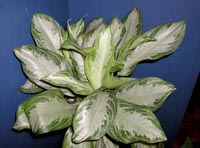Resource Library
Plant of the Week: Silver Bay Chinese Evergreen
The University of Arkansas System Division of Agriculture does not promote, support or recommend plants featured in "Plant of the Week." Please consult your local Extension office for plants suitable for your region.
Plant of the Week
Silver Bay Chinese Evergreen
Latin: Aglaonema Silver Bay

As we become garden shut-ins until spring, houseplants suddenly hold more interest. If you haven’t noticed, there’s a minor revolution occurring in the houseplant world as new hybrids of old favorites greet us each time we prowl the isles of our local garden centers.
One to undergo a genetic transformation is the old favorite, the Aglaonema or Chinese Evergreen. Though there are about a hundred named introductions now listed, I will just focus on one, Silver Bay Aglaonema.
Silver Bay is one of Dr. Jake Henny’s hybrids from the University of Florida’s Apopka foliage research station. Henny, who specializes in breeding members of the philodendron family, has worked as a foliage breeder since 1980 and has released at least six Aglaonema hybrids, four Anthuriums, ten Dieffenbachia hybrids. He has others in the pipeline.
Silver Bay, released in 1992, has become popular in the $585 million Florida foliage industry. Henny’s breeding goals are to introduce larger Aglaonema plants that have unique leaf variegation patterns, good basal branching and cold tolerance. In short, he’s looking for plants that will be easy for Florida foliage growers to produce and easy for retail nurseries to sell.
Silver Bay is a large, robust plant that will reach about 30 inches tall and 36 inches across when grown in a 12-inch pot. The leaf blade is a foot long and 4 inches wide with the petiole about 5 inches long. The inner portion of the leaf is a field of solid grey with the outer third of he leaf marked with a patchwork of alternating tones of green and grey. The canes are typical for the species with good basal branching.
Henny was one of the first breeders to take advantage of a plant-growth hormone called gibberellic acid (GA) in a controlled breeding program. Aglaonemas flower, but flowering is unpredictable and with different species blooming at different seasons. But, after a single GA spray, flowers appear in three to four months, making it easier to concentrate bloom for use in his breeding program.
Once the flowers formed, he set out to understand how certain characteristics were inherited in Chinese Evergreens. After a series of controlled crosses, he discovered that the variegated leaf pattern was due to a single dominant gene. But when variegated parents with a heterozygous chromosome makeup were used, seedlings could be produced that displayed variegation patterns derived from both parents. With this knowledge, he identified parents that would provide the traits he was looking for.
Breeding for leaf variegation characteristics is relatively easy in Aglaonema because plants show their adult variegation patterns as soon as the first leaf appears. It takes at least a year of growing to get a feel for what growth form the plant has and several more years of experience to know if it is easy for growers to produce and tough enough for the homeowner.
These new Chinese Evergreen hybrids are probably the best of all mid-size foliage plants. They are large enough to have a significant impact on the interior landscape and tough enough to thrive with average household conditions. Aglaonemas are native to the monsoon forests of Southern China, an area where six months of wet, dripping weather is followed by an equally long dry spell.
Because of their tolerance for both moist and dry conditions and the fact that they will thrive with very low light conditions, they make an excellent houseplant. Silver Bay’s ability to thrive in cooler indoor temperatures is also a real plus. The new hybrids are self-branching, so they produce new shoots to keep the basal stems covered with foliage. Chinese Evergreens are amongst the most pest free plants even though mealybugs and spider mites will occasionally attack them.
By: Gerald Klingaman, retired
Extension Horticulturist - Ornamentals
Extension News - December 10, 2004
The University of Arkansas System Division of Agriculture does not maintain lists of retail outlets where these plants can be purchased. Please check your local nursery or other retail outlets to ask about the availability of these plants for your growing area.